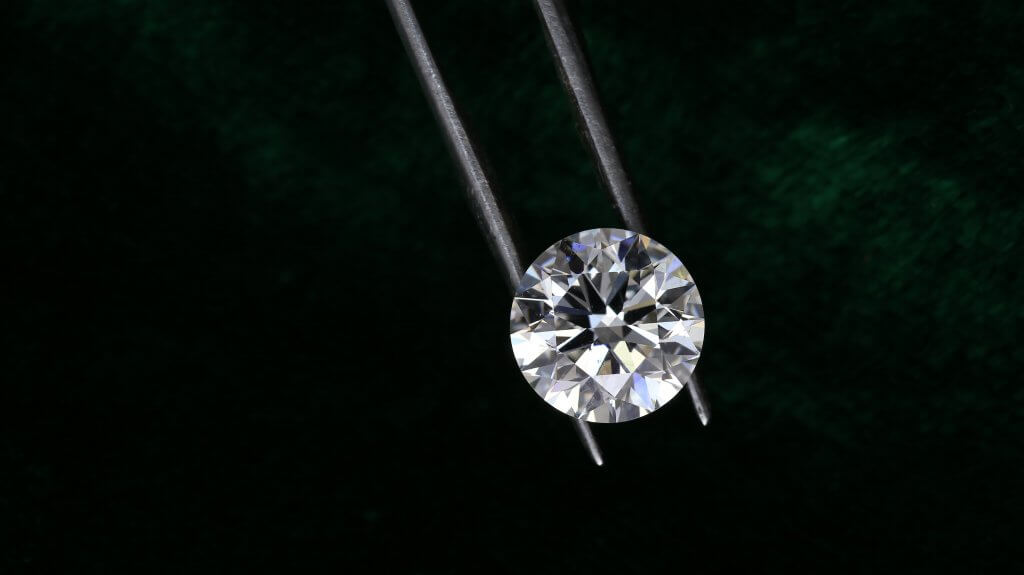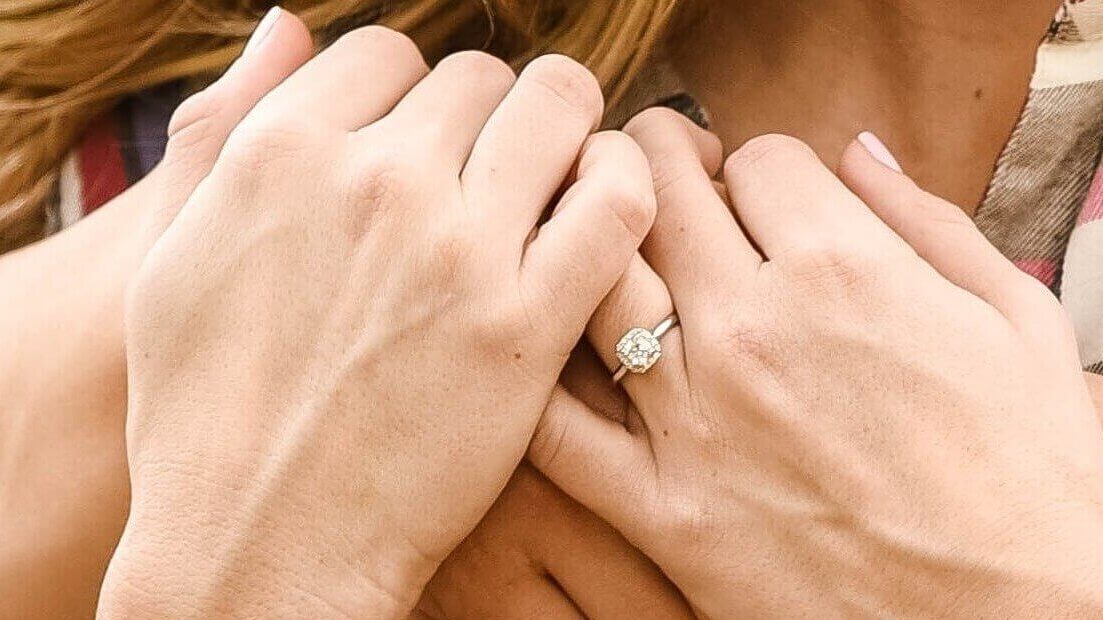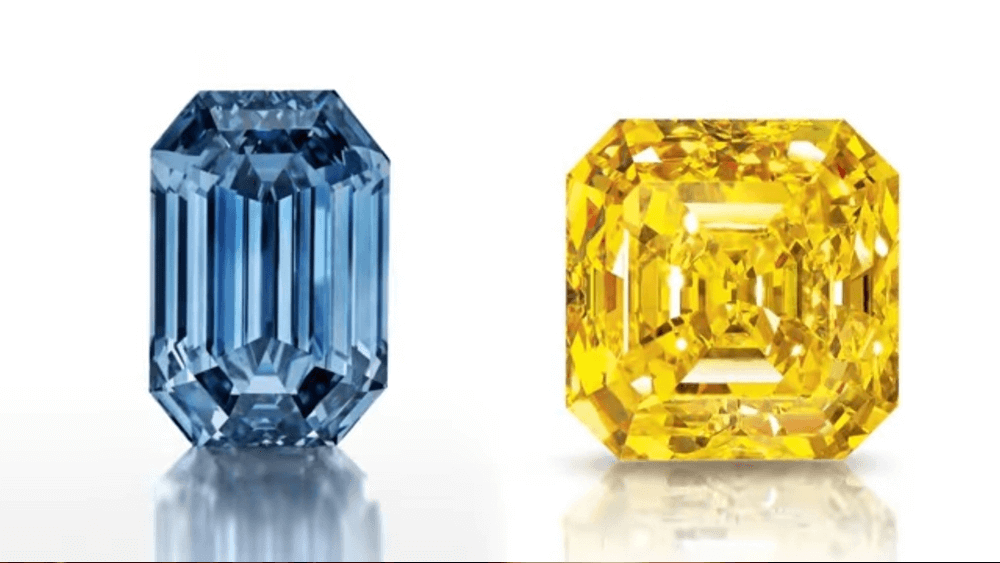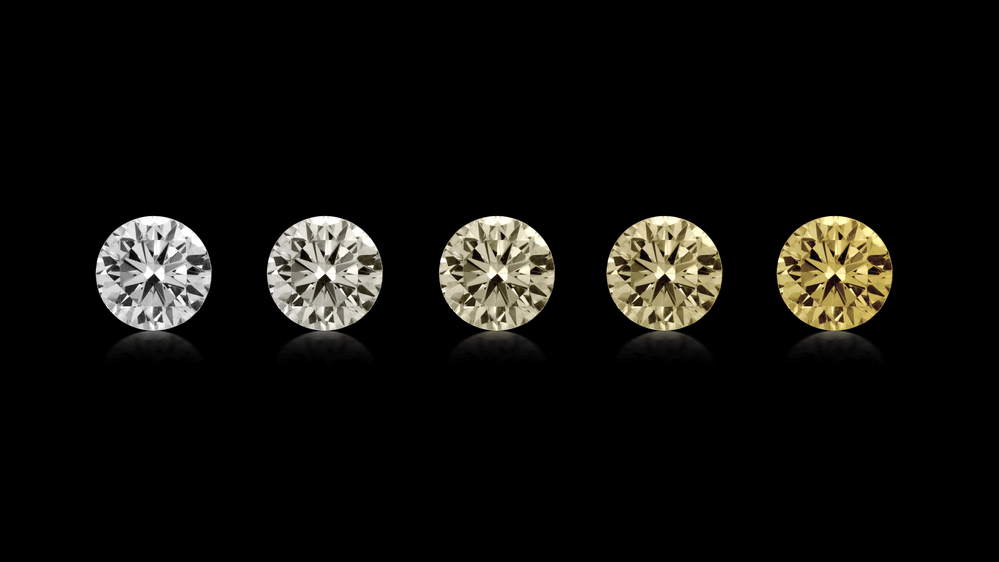Diamond Color vs Clarity: What Matters More?

By Gary A.

Edited by Olivia H.
Published Sep 2, 2021
Edited on Dec 18, 2024
When choosing between color vs clarity in a diamond, finding the perfect balance can make all the difference in creating a ring that shines brilliantly without breaking the bank – but which one matters more to you?

Navigate This Guide:
- 6 Quick Tips for Assessing Diamond Color and Clarity
- Introduction
- The Intricacies of Diamond Color
- Grasping the Color Scale: D to Z
- Clarity: A Diamond’s Inner World
- Clarity vs Color
- Our Expert Take
- 7 FAQs on Diamond Color vs. Clarity
Before we dive deeper into the specifics, here are some practical tips to help guide your decision-making process:
6 Quick Tips for Assessing Diamond Color and Clarity
When embarking on the journey of buying a diamond engagement ring, paying close attention to the color and clarity can make a substantial difference. Here are essential tips to help you navigate these crucial aspects, ensuring you choose a ring that sparkles with both beauty and value.
- Tip 1: Grasp the Nuances of the Color Scale: Understanding the GIA color grading scale is fundamental. Ranging from D (colorless) to Z (light yellow or brown), each grade affects the diamond’s appearance and price. Remember, even subtle color variations can influence the overall look of the diamond.
- Tip 2: Reflect on the Setting’s Influence: The ring setting can significantly impact how the diamond’s color is perceived. For example, yellow gold settings can diminish the appearance of yellowish hues in lower-grade diamonds. In contrast, platinum or white gold settings can highlight the colorlessness in higher-grade diamonds.
- Tip 3: Emphasize the Importance of Cut: The quality of a diamond’s cut is a game-changer. A well-executed cut can enhance both the color and clarity of a diamond. Diamonds with a lower color or clarity grade can appear more luminous and flawless with an expert cut.
- Tip 4: Balance Color and Clarity with Your Preferences: Striking the right balance between color and clarity that aligns with your personal preference and budget is key. Opting for the highest grades isn’t always necessary. Sometimes, an eye-clean diamond in a lower clarity grade offers exceptional value without compromising on beauty.
- Tip 5: Assess in Different Lighting Conditions: The true colors and clarity of a diamond reveal themselves under varying lighting conditions. Evaluate the diamond in different lighting environments, including natural light, to ensure it meets your expectations in all settings.
- Tip 6: The Clarity Check: Employing a jeweler’s loupe or a magnification tool is crucial, especially for clarity assessment. Some inclusions, not visible to the naked eye, can significantly impact the diamond’s quality. A detailed examination can help you understand the true clarity of your diamond.
Now that you’ve got these practical tips, use Jeweler AI below to find the perfect engagement ring that suits your style and budget:
Introduction
When you finally start to learn about the four Cs of diamonds, you’ll find that doing so can instantly make the path forward look a little clearer. By getting comfortable with the language surrounding a diamond’s most important characteristics, and learning how to interpret each grading system, you can make a much wiser investment.
However, don’t fall into the trap of thinking it’s plain sailing from there on out. Learning how to balance each of the four Cs – and, of course, how to find a diamond that checks all your boxes – is an art in and of itself. While it would be easy to simply look for a diamond with the highest possible grades in all categories, it’s just not possible – or advisable.
Not only are these diamonds incredibly rare, but a large, internally flawless D color diamond is going to cost far more than you actually need to budget for in order to create the perfect ring. Yes, it would be easier – but, let’s face it, it’s not going to happen.
Instead, you’ve got to continually weigh up your options, compare and contrast two marginally different diamonds, and learn how not to shoot for perfection, until you eventually strike gold. Or, in this case, a diamond.
The Intricacies of Diamond Color
Out of all the four Cs, this one is probably the first one to cause much confusion in first-time shoppers, since, unless you’re going against the grain and picking a fancy colored diamond, there doesn’t seem to be much use for the color grading system, right? Think again…
Why Understanding Diamond Color is Important
Put simply, it’s important because you don’t want to overspend on too high a color grade, or underspend on a color grade that will look low quality in your ring.
You don’t have to pick a D color diamond to make the most out of your budget, since the difference will be far too subtle to matter – particularly when it’s worn on the finger as part of a stunning ring. Under normal lighting, the difference between two good color grades won’t be visible.
While diamond shopping would definitely be much easier if we could rule out one of the four Cs entirely and give ourselves one less thing to worry about when we look over those GIA Reports, it would be a bad idea to head out there without paying any attention at all to the color grade.
On the one hand, you could end up paying a high price for a superior grade that barely looks any different to a lower, more affordable grade – meaning you’ll have less to spend on more conspicuous features, such as cut and carat weight. For instance, it’s pretty unlikely you’ll notice any difference between this D color Round Diamond and this G Color Round Diamond – especially when they’re both worn against the skin – although there will be a significant price difference between the two.
On the other hand, you could end up with a diamond that features a visible tint that detracts from the ‘wow factor’ you’re looking for and, in a word, looks a little antiquated.
So, yes, diamond color matters, but D colored diamonds definitely don’t need to represent the aim of the game. Provided you don’t dip below a certain level, you’ll not need to worry too much.
Grasping the Color Scale: D to Z
Color ranges from D (colorless) to Z, although jewelers will rarely offer diamonds anywhere near that low. Z color diamonds will feature a conspicuous yellow-brown color, not to be confused with the separate grading system used for fancy colored diamonds.
We don’t recommend going any lower than a J color diamond. A K color or lower will feature too much unwanted color, and will disrupt the natural beauty that we all want to find within our chosen diamond. There is definitely a reason why these diamonds are significantly lower in value.
But, as we mentioned above, some cuts do show their color more than others. For instance, a J color Cushion or Pear cut diamond will likely show more of a tint than a round cut diamond so, in this case, it’s vital you understand the specifics of the cut while you search. A photograph and a video are definitely useful tools when you’re browsing, but you can’t put your money on the line when it comes to something this important. Shop from a seller who maintains their own rigorous QA processes, like ours, for that added guarantee.
Similarly, the color of the setting can also help to complement or mask any unwanted yellow coloring in your diamond. A diamond with a lower color grade can look stunning against the much warmer hues of yellow or rose gold, which can off-set any slight yellowing. On the other hand, a near-colorless diamond will dazzle against a bright platinum band.
Color’s Role in Aesthetics and Value
Diamonds are known for their beautiful, clear, structure. Colored diamonds – or, as they’re known in the industry, fancy colored diamonds – are very popular among certain buyers for their beautiful hues and rarity, but most engagement rings feature a white diamond.
The trouble is, as diamonds form, it’s relatively common for them to take on slight traces of other chemical elements – i.e., other than the carbon from which the diamond is formed. Some of these trace elements create an unwanted yellow cast in the diamond – and that can easily make a diamond appear, well, not like a diamond.
While fancy yellow diamonds are valued by collectors, white diamonds with a low color grade are very different – and much less attractive.

Clarity: A Diamond’s Inner World
A diamond’s clarity grade, on the other hand, refers to how many (or few) inclusions and blemishes it features. Many of these inclusions are natural, and develop over billions of years a little like birthmarks. For the most part, they are also buried deep within the internal structure of the diamond. Some surface blemishes, however, can be natural, or caused by the handling and cutting process after they are taken from the earth.
In both instances, the most sought-after diamonds are of course those with no discoloration, inclusions, or blemishes. Perfection comes highly prized among collectors, although the natural charm of minor inclusions is also admired by many diamond wearers around the world.
Chances are, you’ve already heard about eye clean diamonds but, if you’re still pretty early on in your diamond-hunting process, the term probably still goes over your head somewhat. After all, it’s a little more subjective than simply reading through a GIA Grading Report and making your decision based on that.
Like anything, though, you’ve just got to find the right place to start…
Decoding the Clarity Grades
The clarity grades run from FL and IF (Flawless and Internally Flawless), through VVS1 and VVS2 (Very Very Slight Inclusions), VS1 and VS2 (Very Slight Inclusions), SI1 and SI2 (Slight Inclusions), and I1 and I2 (Inclusions). The differences between each grade are visible on a microscopic level but, as you move further down the scale, you will start to see those inclusions with the naked eye.
Always aim for eye cleanliness, which usually falls around a grade of VS1.
As mentioned, the difference between a VS1 diamond and a VVS diamond is going to be visible only under magnification, and both would look pretty much identical (provided they’re of similar cuts, colors, and carat weights) if you were to look and hold them in person.
For that reason, unless you’re seduced by the idea that your VVS diamond is verging on perfect, there really is no point investing an additional lump sum into this clarity grade.
The Allure of Eye Clean Diamonds
Eye clean diamonds are popular for two key reasons: they’re cheaper since they’re available around the VS and SI grades, and they look just like much more expensive diamonds graded as VVS or even IF.
Clarity vs Color
So, now that we’ve covered the basics, how are you supposed to think about one alongside the other – and, for anyone with any sort of a budget to follow, which one is more important? While we would always recommend that you focus on finding that elusive balance between clarity and color, they’re not exactly ‘created equal’.

Is Diamond Clarity Really Important?
Yes but, as with diamond color, you don’t need to shoot for the very highest grades in order to find a stunning, eye clean diamond. This is where you really need to be led by eye cleanliness.
We can rule FL (flawless) diamonds out of the equation entirely. Not only are they incredibly rare, but they’re far too expensive to prove worthwhile to the overwhelming majority of people looking to purchase a diamond for an engagement ring.
Why? Because, for a diamond to be flawless, it needs to have no blemishes visible at up to 10x magnification. Considering the human eye can’t appreciate perfection at that level of magnification, there really is no use in paying for it unless you’re an avid diamond collector.
For that reason, the same thing holds true for IF or internally flawless diamonds. They’re incredible, yes, but they’re not worth it unless you’ve got an unlimited budget to work with.
Like the color grades, many of the higher grades will be both more affordable and, to the human eye, appear unflawed.
Does Color or Clarity Make a Diamond Sparkle?
Clarity has more impact on a diamond’s brilliance and fire than color, although its cut is by far the most important factor when it comes to maximizing sparkle.
One of the main reasons why internally flawless and very, very slightly included diamonds are so popular is because visible inclusions can interrupt the diamond’s light performance since noticeable inclusions will prevent light from travelling so ‘cleanly’ through the center of the diamond.
But, while a large cloud or feather (two common types of inclusion) will dull an otherwise magnificent and mesmeric dance of light through the diamond, that’s not to say that a VS diamond is a poor purchase compared with a VVS2 diamond. Provided it is eye clean, then a well-cut diamond will sparkle beautifully.
Understanding which diamond cut sparkles the most are far more important than agonizing over two eye-clean grades for clarity – or, of course, color.
Is Color or Clarity More Expensive?
Both factors have a pretty significant impact on the diamond’s value, alongside cut and carat weight. Any grade of color or clarity that appears eye clean will come at a premium.
Look at it this way, you’re (hopefully) never going to shop around for a diamond with a very, very high color grade and a very low clarity grade – or vice versa – so it’s much more helpful to know whether you should be aiming for with regards to both, rather than how each one value on its own.
When it comes to color, an E or F color diamond is considered colorless, while G, H, I and J color diamonds are ‘near colorless’, as the yellow tint is barely noticeable. In general, you should stick within this parameter – although some cuts, such as the Cushion, and certain settings will necessitate a higher color grade.
When it comes to clarity, the same basic principle holds true: the top grades, all the way down to around about VS1, will appear eye clean.
So, What Clarity and Color is Best for Diamonds?
If you’re on a budget, start by looking at J color VS1 diamonds. That way, you can ensure that you don’t dip below a certain quality, and that eye cleanliness will still be attainable.
Many people presume that ‘making sacrifices’ means settling for a poorer quality diamond. This is definitely not true – it simply means realizing that perfection is costly, and not quite as great a choice as it might sound at first.
Before you jump to any conclusions, however, it’s definitely worth using our Diamond Search Engine to filter down results until you hit upon something that speaks to you. Depending on your budget, you might then start increasing your specifications – whether for color or clarity or, of course, cut and carat weight – until you find your ‘ideal balance’.
At that point, we advise that you head over to our store and begin your search. This is a vital step because all diamonds have their own unique character; even if you’ve struck a good balance between the four Cs, that’s not to say the first diamond you hit upon will be the perfect one for you.
Our Expert Take
In our opinion, striking a balance between both features is far, far more important than prioritizing one over the other. A diamond that has been graded as internally flawless, but which features a distinctly yellow tint, will look less impressive than an eye clean, near-colorless diamond.
Color does give slightly more scope than clarity. For eye cleanliness, you ideally want to aim for around VS1 or VS2, whereas near-colorless diamonds include grades G, H, I, and J. What’s more, it is easier to complement a very slightly discolored diamond with clever settings choices than it is to hide inclusions, particularly if they are scattered across the center of the diamond.
Nevertheless, we would never recommend that anyone looking for a diamond to sit in the center of their engagement ring focus all their attention on one aspect of the ring, and only pay lip service to another.
Remember that, while a VVS E or F color diamond is ideal, you still need to take into account the diamond’s cut and carat weight – both of which have a more significant impact on the first impression your diamond will make.
7 FAQs on Diamond Color vs. Clarity
- Q: What matters more in a diamond, color or clarity?
- A: Both are important, but it often depends on personal preference and the diamond’s setting. Generally, a balance between the two should be sought, prioritizing what is visually most important to you.
- Q: Can you see the difference in color grades with the naked eye?
- A: The difference between adjacent color grades is usually not visible to the untrained eye, especially when the diamond is set in a ring.
- Q: Is an eye-clean diamond in lower clarity grades a good choice?
- A: Yes, an eye-clean diamond (one without visible inclusions to the naked eye) in a lower clarity grade can offer excellent value and appearance.
- Q: How does the setting affect a diamond’s appearance?
- A: The setting can influence the perceived color of a diamond. For example, yellow gold settings can make lower color grade diamonds appear more colorless.
- Q: What is the best way to assess a diamond’s clarity?
- A: Using a jeweler’s loupe or magnification tool is the best way to assess a diamond’s clarity, as some inclusions are invisible to the naked eye.
- Q: Does the shape of the diamond affect color and clarity perception?
- A: Yes, the diamond shape can impact how color and clarity are perceived. For example, round diamonds hide color well, whereas emerald cuts make inclusions more visible.
- Q: Should I prioritize color or clarity for a brilliant sparkle?
- A: While both contribute, cut quality is the most critical factor for brilliance and sparkle. However, clarity can impact sparkle if inclusions are significant.
Discover your ideal diamond with Jeweler AI – where color and clarity come to life.
FOLLOW-UP GUIDE SERIES












